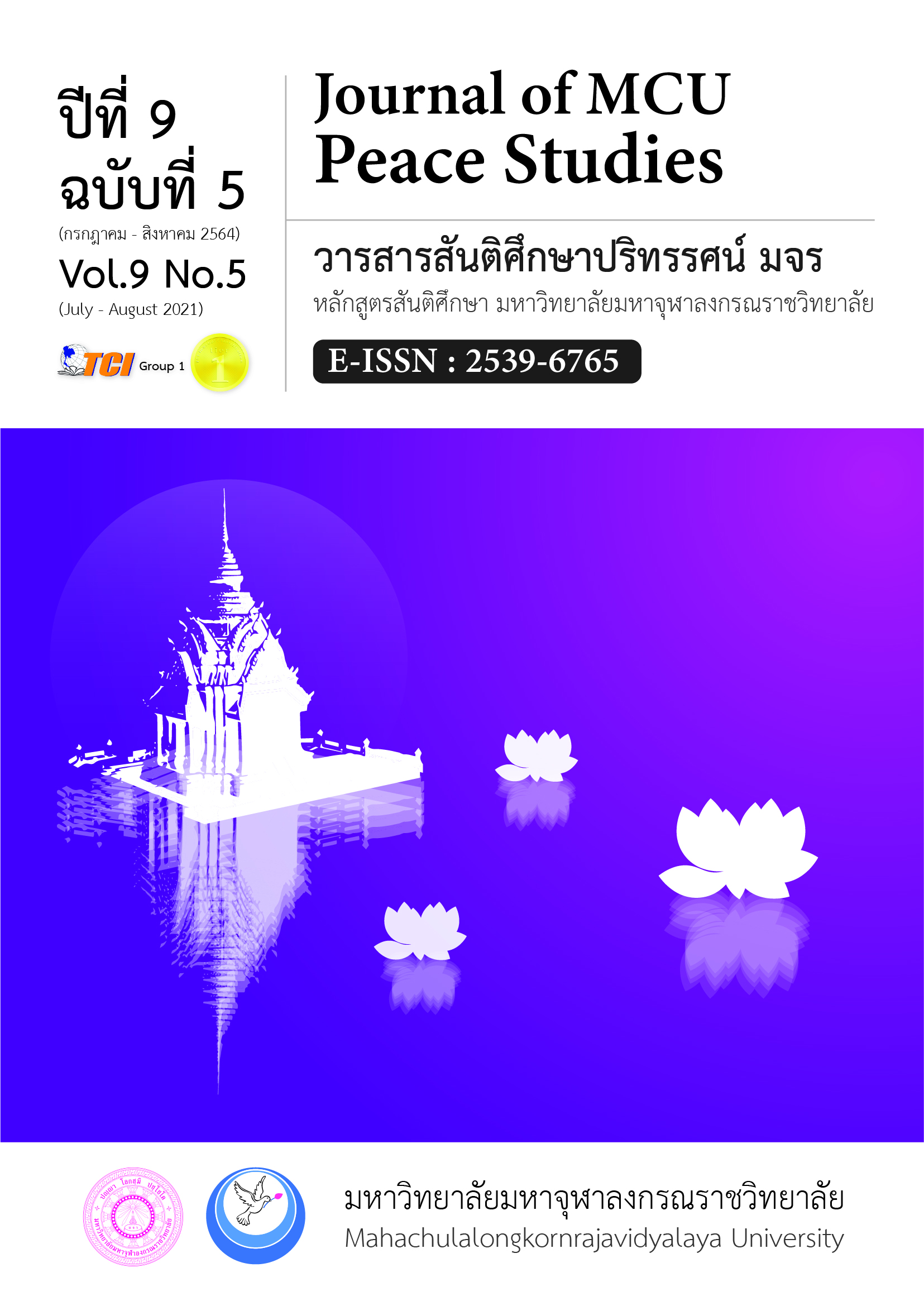นัตพม่ากับการเมืองวัฒนธรรม: ความสัมพันธ์เชิงอำนาจ ทางการเมืองวัฒนธรรมในพื้นที่ความเชื่อเรื่องนัตในประเทศเมียนมา
Main Article Content
บทคัดย่อ
บทความวิจัยนี้มีวัตถุประสงค์เพื่อ 1) ศึกษาประวัติความเป็นมาของความเชื่อเรื่องนัตของเมียนมาท่ามกลางกระแสการเปลี่ยนแปลงของประวัติศาสตร์ทางการเมือง ประวัตินัตสำคัญ พิธีกรรมการบูชานัต ตลอดจนผลประโยชน์ที่เกิดขึ้นในพื้นที่ความเชื่อเรื่องนัต 2) วิเคราะห์บทบาท การต่อสู้ต่อรองและการประนีประนอมของฝ่ายผู้ปกครองและฝ่ายประชาชนในพื้นที่ความเชื่อเรื่องนัต และ 3) วิเคราะห์ภาพสะท้อนความสัมพันธ์เชิงอำนาจทางการเมืองวัฒนธรรม และภาพสะท้อนของประชาธิปไตยเชิงวัฒนธรรมในพื้นที่ ความเชื่อเรื่องนัต โดยงานวิจัยนี้ใช้ระเบียบวิจัยเชิงคุณภาพ เก็บข้อมูลจากเอกสาร การสังเกต และ การสัมภาษณ์เชิงลึก และนำข้อมูลมาวิเคราะห์/ตีความตามกรอบแนวคิดของการวิจัย ผลการวิจัยพบว่า 1) ความเชื่อเรื่องนัตมีความเกี่ยวข้องกับการเมืองมาตลอดในประวัติศาสตร์เมียนมา นัตองค์สำคัญจำนวนมากมีประวัติและพิธีกรรมการบูชาเกี่ยวข้องกับการเมือง อีกทั้งพื้นที่ความเชื่อเรื่องนัต ก็ยังมีผลประโยชน์ที่ส่งผลให้หลายฝ่ายเข้ามาเกาะเกี่ยว 2) ทั้งผู้ปกครองและประชาชนต่างได้เข้ามาเกี่ยวข้องและมีบทบาทในพื้นที่ความเชื่อเรื่องนัต โดยฝ่ายผู้ปกครองได้ใช้อำนาจรัฐควบคุมพื้นที่นี้มาโดยตลอด เพื่อการสถาปนาอำนาจนำของฝ่ายตน ในขณะที่ฝ่ายประชาชน ก็ต่อรองอยู่เสมอเพื่อรักษาไว้ซึ่งพื้นที่ทางวัฒนธรรมของตน 3) จากข้างต้น พื้นที่ความเชื่อเรื่องนัตจึงเป็นพื้นที่ของความสัมพันธ์เชิงอำนาจ ที่ฝ่ายต่าง ๆ โดยเฉพาะผู้ปกครองและประชาชนเข้ามาต่อรองและประนีประนอม เกิดเป็น “เครือข่ายการครองความเป็นจ้าวทางวาทกรรม” ที่ประชาชนเข้าไปเป็นส่วนหนึ่ง สะท้อนประชาธิปไตยเชิงวัฒนธรรมหรือ “ประชาธิปไตยเชิงลึก” นั่นเอง
Article Details
ทัศนะและความคิดเห็นที่ปรากฏในบทความในวารสาร ถือเป็นความรับผิดชอบของผู้เขียนบทความนั้น และไม่ถือเป็นทัศนะและความรับผิดชอบของกองบรรณาธิการ ยินยอมว่าบทความเป็นลิขสิทธิ์ของวารสาร
เอกสารอ้างอิง
Andaya, B., & Ichii, Y. (1993). Religious Developments in Southeast Asia c. 1500–1800. In N. Tarling (Eds.), The Cambridge History of Southeast Asia (508-571). Cambridge: Cambridge University Press.
Anantapark, A. (2013). Myanmar History: The Land of Disharmony. Bangkok: Gypsy Groups.
Barker, C. (2008). Cultural Studies: Theory and Practice. (3rd ed.). London: Sage.
Charoensin-o-larn, C. (2001). Critical Political Science. (2nd ed.). Bangkok: Thammasat University Press.
Charoensin-o-larn, C. (2006). Development Discourse: Power Knowledge Truth Identity and Otherness. (4th ed.). Bangkok: Vibhasa.
De Casparis, J. G., & Mabbett, I. W. (1993). Religion and Popular Beliefs of Southeast Asia before c.1500. In N. Tarling (Eds.), The Cambridge History of Southeast Asia (276-340). Cambridge: Cambridge University Press.
De la Perriere, B. B. ( 1996) . The Burmese Nats: Between Sovereignty and Autochthony. Diogenes, 44/2(174), 45-60.
Gramsci, A. ( 1971) . Selections from the prison notebook. edited by Hoare, Q. and Nowell, S.G. New York: International Publishers.
Harnwong, L. (2019). Religion and Politics in Burma: On Making Buddhism a National Religion, 1948-1962. In Hongsaton P. and Marddent A. (Eds.), Religion and Violence (45-77). Bangkok: Illumination Editions.
Htin, Aung. (1967). A History of Burma. New York: Columbia University Press.
Kaewthep, K. ( 1998) . Mass Media Studies with Critical Theory: Concepts and Research Examples. Bangkok: Printmaking.
Laclau, E., & Mouffe, C. ( 2 0 0 1 ) . Hegemony and Socialist Strategy: towards a Radical Democratic Politics. (2nd ed.). London: Verso.
Mendelson, E. M. ( 1975) . Sangka and State in Burma: A Study of Monastic Sectarianism and Leadership. Ithaca, NY: Cornell University Press.
Ministry of Information of Myanmar. (2002). Myanmar Facts and Figures. Yangon: Ministry of Information.
Mouffe, C. ( 1984) . Towards a Theoretical Interpretation of ‘New Social Movements’. In S. Hanninen and L. Palden ( Eds.) , Rethinking Marx. New York and Bagnolet: International General/IMMRC.
Niyomtham, W., & Niyomthan, O. (2008). Learning Myanmar Society and Culture. Phitsanulok: Center of Myanmar Study, Faculty of Humanity, Naresuan University.
Santasombat, Y. (2013). Human and Culture. (4th ed.). Bangkok: Thammasat University Press.
Schliesinger, J. (2018). The Cult of the Thirty-Seven Spirits (Nats) in Burma: Merging Animism and Buddhism. Bangkok: Booksmango Incorporated.
Srigate, G. (2021). The Nats Cult and Cultural Politics: Multiculturalism in Urbanizing Mandalay. Journal of Social Sciences, 51(1), 147-168.
Stange, P. (1993). Religious Change in Contemporary Southeast Asia. In N. Tarling (Eds.), The Cambridge History of Southeast Asia (529-584). Cambridge: Cambridge University Press.
Steinberg, D. I. (2012). The Problem of Democracy in the Republic of the Union of Myanmar: Neither Nation-State Nor State-Nation? Southeast Asian Affairs, January 2012, 220-237.
Stevenson, H.C. ( 1 9 4 4 ). Burma Pamphlets No. 6, The Hill Peoples of Burma. New York: Longmans, Green & Co.
Sujchaya, S. (2009). Mon, Ethnic in the Land of Suvarnabhumi. Retrieved June 20, 2019, from http://www.monstudies.com.
Tangsupvattana, A. (1992). Models of Power: A Reflection of Meta – theoretical Controversy. (Master’s Thesis). Department of Government, University of Essex. Colchester.
Taylor, R. H. (2009). The state in Myanmar. Singapore: NUS.
Temple, R. C. ( 1906) . The Thirty-Seven Nat: A Phase of Spirit-Worship Prevailing in Burma. London: W. Griggs.
Than Tun, T. (1983). The Royal Orders of Burma, A.D. 1598-1885. Kyoto: Center for Southeast Asian Studies, Kyoto University.
Thotsaroth, N. (1997). Nat Belief in Burmese society. Nakhon Pathom: Research Institute for Languages and Cultures of Asia.
Win Maung, Y. (2015). Bagan 37 Pagodas and 37 Nats. (translated into English by Tin Thet, Hteik). Mandalay: Cho Cho Myint.


